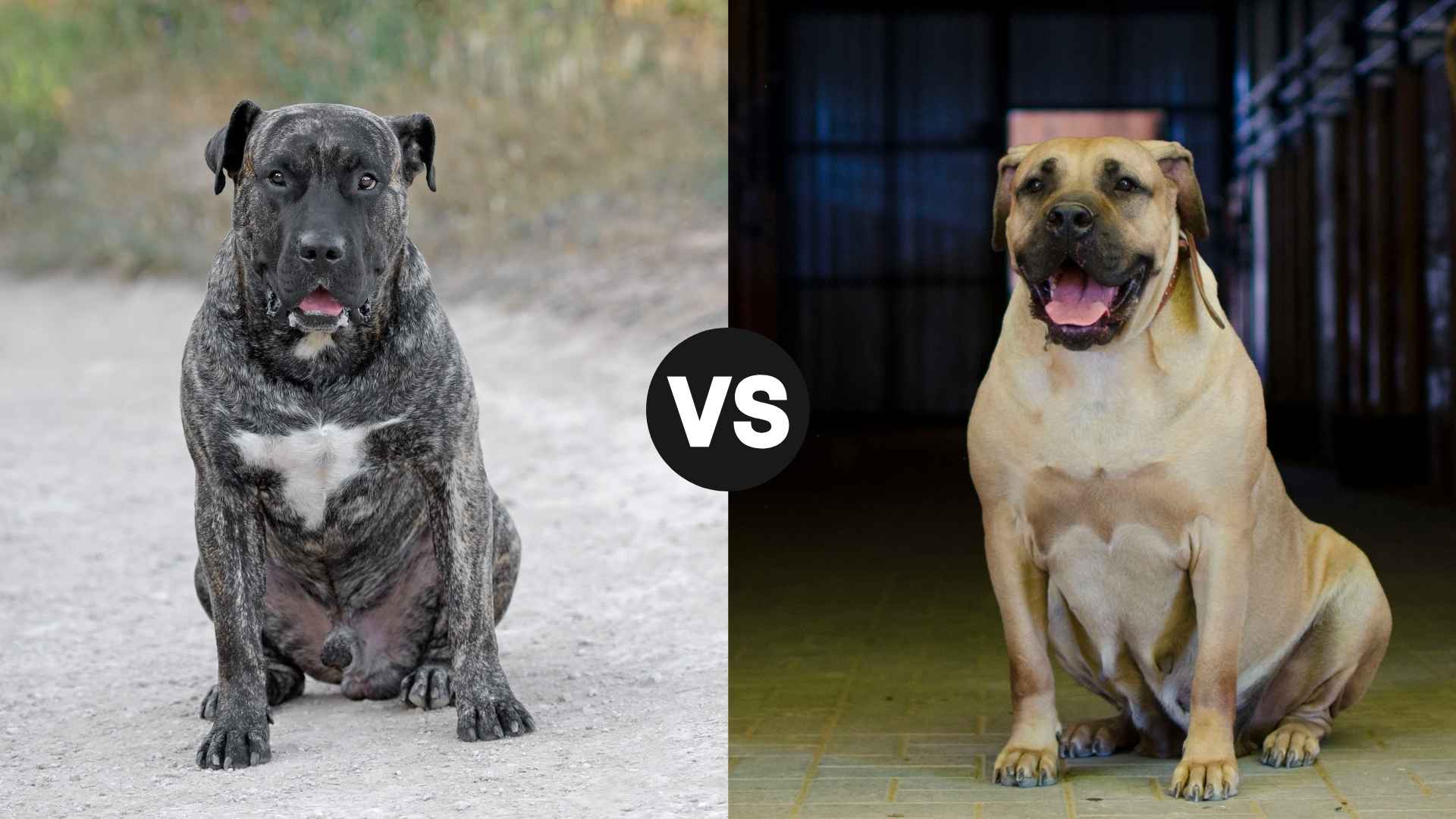The Presa Canario and the Boerboel are both serious working breeds that were bred for power, protection, and purpose.
While they share an equally stern vibe, they come from different worlds. One was raised on volcanic islands to manage livestock, the other was bred on the rugged farmlands of South Africa to protect property.
That’s why their instincts, strengths, and temperament are worth exploring. This guide breaks down both large breeds’ history, build, instincts, working roles, and behavior to give a full picture and add to your canine knowledge.
Presa Canario vs. Boerboel
Presa Canario vs. Boerboel: Key Differences Overview
Before we talk about these breeds’ exclusive traits, here’s an overview of their primary differences:
The Presa Canario was bred on Spain’s Canary Islands as a catch and guard dog to seize stray cattle and stand watch over remote homesteads and livestock fences. However, the Boerboel comes from South Africa, where farmers needed a mastiff tough enough to face hyenas and sometimes even lions.
Another thing setting these two canines apart is their build. The Presa is more compact, weighing 84-110 pounds, while the Boerboel can go up to 200 pounds, as per the AKC.

These dogs’ temperaments also differ. A Presa Canario is on serious alert and naturally suspicious of strangers (as seen by its barking) because it’s inherently a watchdog. Boerboels are also protective, but they’re calmer and more stable.
Comparison of Physical Appearance and Build
Presas and Boerboels are mastiff dogs (large, heavy, and broad), but their frames are not the same. The Presa Canario carries a medium-mastiff outline while the Boerboel is bulkier and more muscular.
Presas are 24-26 inches tall and weigh up to 110 pounds. Its body is longer than tall and gives it a rectangular profile that stays agile on tough island terrain. This pup’s muscles are defined, and its structure is balanced: you’ll see a firm back, a slight tick in the belly, and a low-set tail which is mostly straight. No wonder it’s used in dog fighting (which is brutal and hence declared illegal across all states in the US).
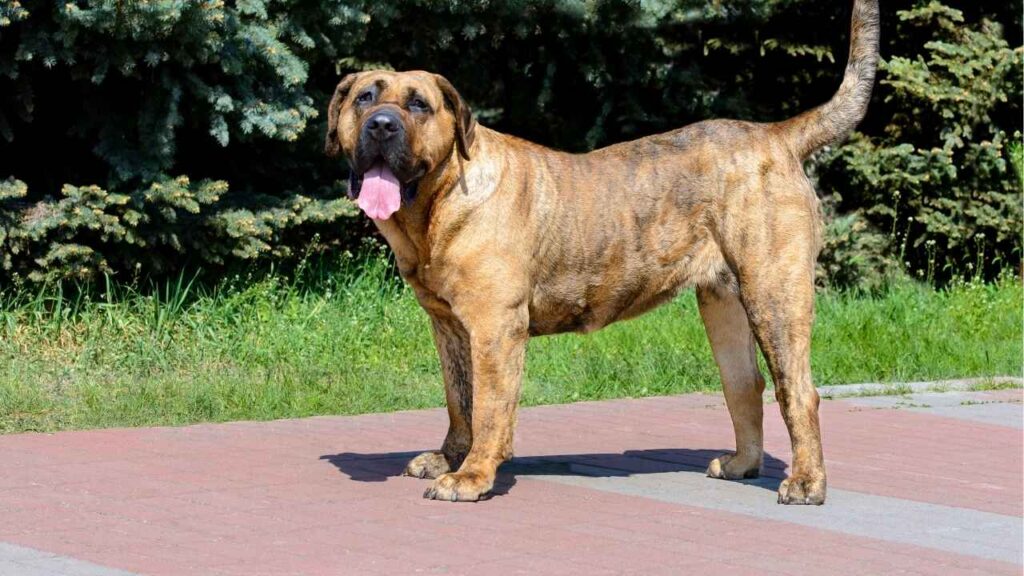
The Boerboel is a bigger and heavier animal than the Presa Canario. This dog’s height can be between 24 and 27 inches (not much difference), but it can weigh up to 200 pounds, making it a big, scary dog. The Boerboel’s body is short and wide with thick bones and deep ribs. Also, their chest reaches down to their elbows, and their frame is built to push back threats like predators or intruders.
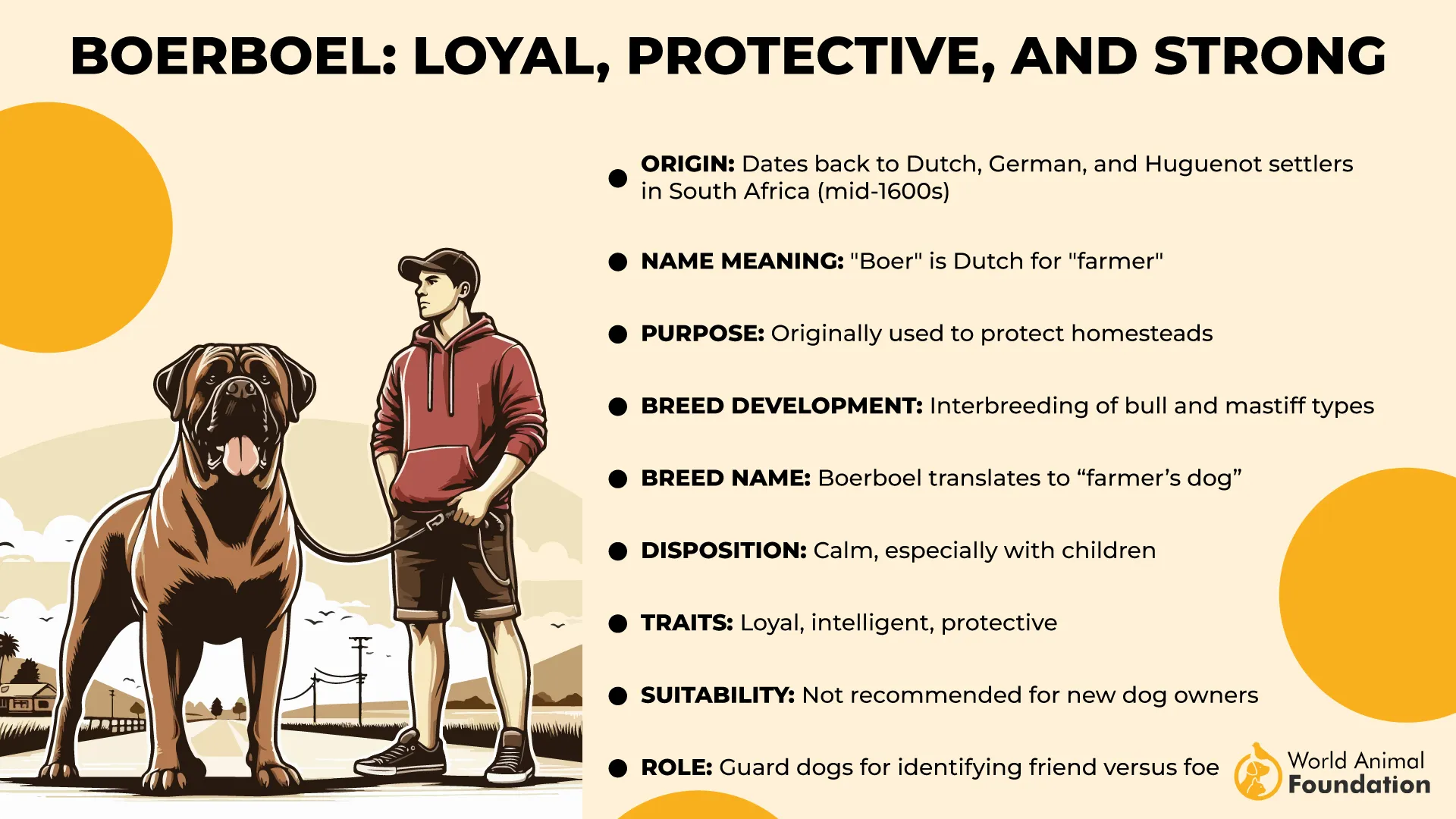
While walking, the Presa is quick and low to the ground, like it’s ready to spring. A Boerboel’s roam, on the other hand, is steady and powerful while covering the ground with strong rear drive.
Trainability and Learning Capabilities
The Presa Canario and Boerboel are both fast thinkers, but they slightly differ.
Presa Canario is intelligent and focused, has a strong-willed temperament, and doesn’t just follow orders blindly. You must be firm and calm, as harsh corrections won’t work. Instead, stick to short training sessions with rewards, praise, and structure. Presas respond best to training that’s respectful and mentally challenging.
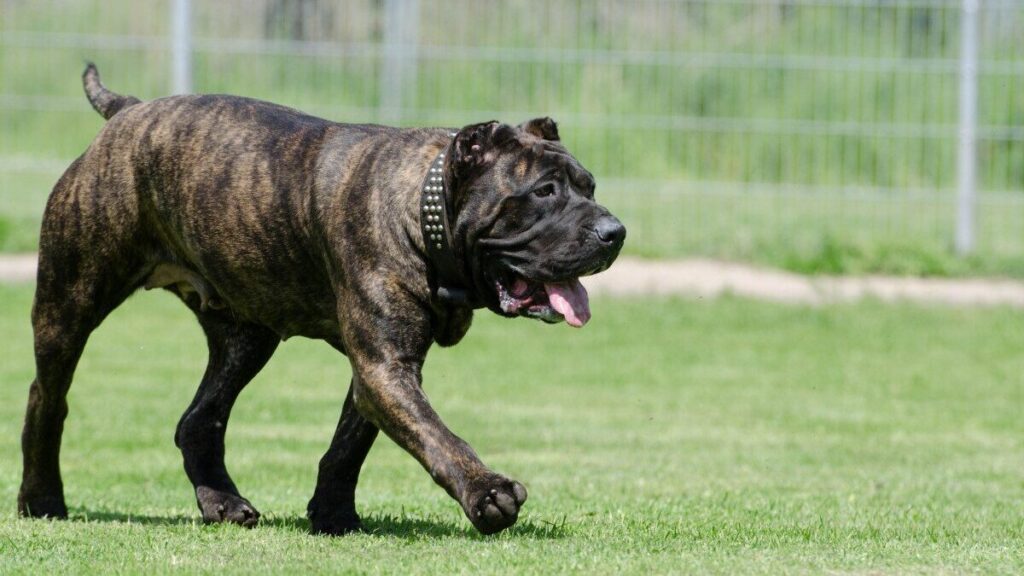
Notably, the Boerboel is more trainable because it’s personally eager to please. It means that teaching it basic obedience is smoother, especially if it’s socialized early. But since Boerboels are dominant by nature, clear boundaries and early structure are crucial for their training. Once they know the rules, they follow them well and stay calm around kids, visitors, and distractions.
Exercise Requirements and Energy Levels
Big dogs need regular exercise, and these two are no exception.
The Presa Canario has high energy and needs daily physical and mental activity, so you can’t leave it idle. This confident pet needs at least an hour of structured exercise broken into walk, play, and training sessions.
Presas enjoy having something to do, such as obedience drills, advanced leash work, and scent games. Without enough to do, they can become destructive or aggressive. In the wrong hands, some were even used for illegal dog fighting in the past, which proves that unmanaged energy can go the wrong way.
The Boerboel has a comparatively calmer nature, but it still needs regular movement like a long walk, backyard time, and mentally stimulating tasks. Because of their size, Boerboels shouldn’t be forced into intense jumping or nonstop running, as that can hurt their joints. Instead, they do best with steady activity like pulling, hiking, and walking.
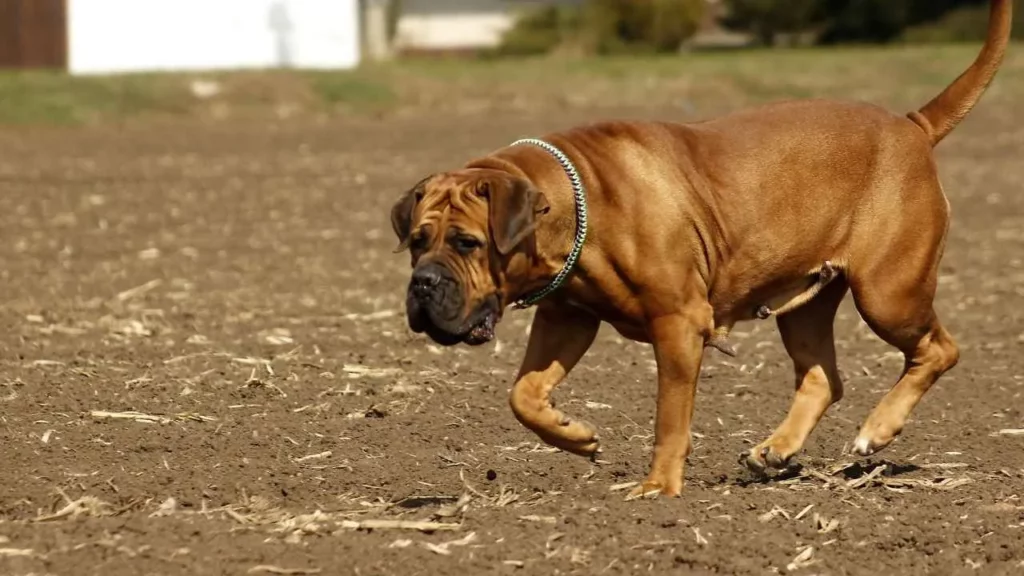
Grooming Needs and Coat Maintenance
Presa Canario has a short and coarse coat that doesn’t trap a whole lot of dirt. It sheds a moderate amount all year and more heavily during spring.
When the shedding is heavier, brushing 2-3 times weekly with a rubber brush or grooming mitt helps manage loose hair (at other times, once a week brushing will do). Presas also don’t need frequent baths because of a short coat, and one bath every four to six weeks is enough.
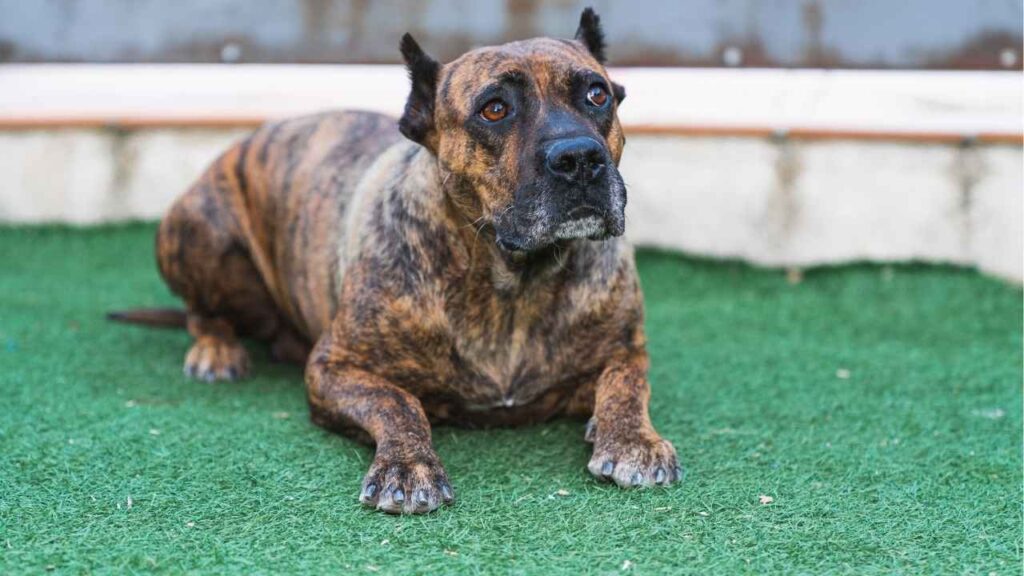
Boerboel also has a short but it feels smoother to the touch. Shedding is similar to the Presa, but because Boerboels are larger, you’ll notice more hair around the house.
Therefore, a weekly brush with a soft bristle brush or mitt is needed to keep this dog breed’s coat clean. Since Boerboels have loose skin around their mouth and face, it helps to wipe those areas daily to prevent skin infections.
Health Considerations and Common Issues
Both Presa Canario and Boerboels come with some health concerns. Both have an average lifespan of 9-11 years, but that depends on how well they’re cared for.
Presa Canarios have joint problems like hip and elbow dysplasia, which is why breeders should screen their dogs and do vigorous health testing before breeding. Another concern in the breed is epilepsy in younger dogs, which can show up between 6 months and 3 years.
Presas are also at risk for heart issues like dilated cardiomyopathy (this condition affects how the heart pumps). Regular vet visits and a good lifestyle can help give these family pets a better and longer life.
According to PetMD, Boerboel shares some of those joint risks, but they’re more prone to eye problems. Conditions like entropion (inward-turning eyelids) and ectropion (outward-turning eyelids) can cause pain and may need surgery.
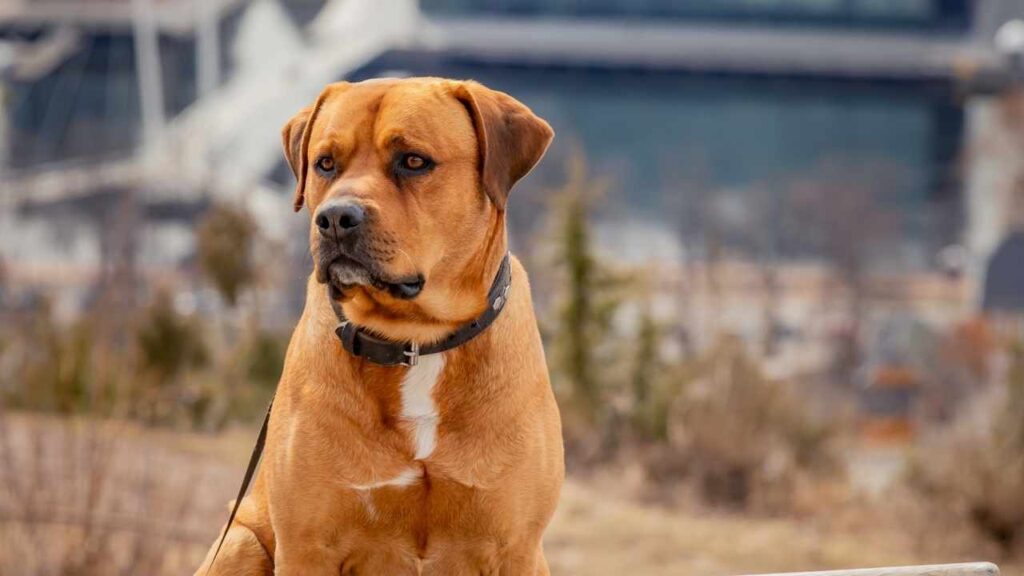
Boerboels’ risk of bloat (a dangerous stomach condition that can turn life-threatening fast) is also high. That’s the reason some owners choose to get a preventive gastropexy during spay/neuter to reduce that risk.
Heart conditions like DCM can show up in this loyal fellow, and their heavy bodies make them prone to arthritis if they grow too fast on the wrong diet.
Conclusion
The Presa Canario and Boerboel carry a serious presence. They walk into a space with calm power and don’t need to prove anything. Their body language, eye contact, and focus say it all.
These dogs are bold, self-assured, and for people who respect that kind of energy. If you’re drawn to a dog that holds its ground without showing off, either of these two will speak your language.


